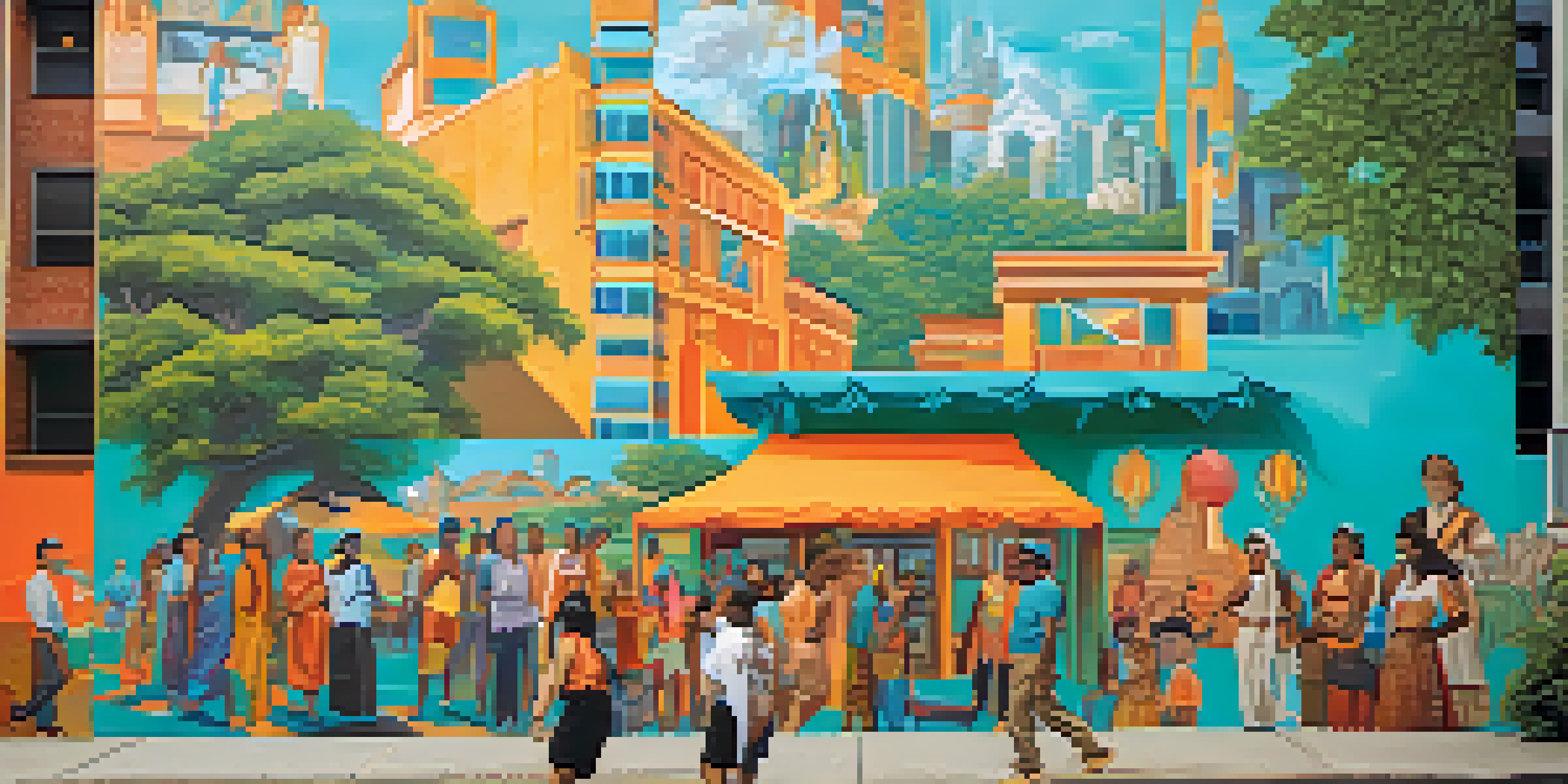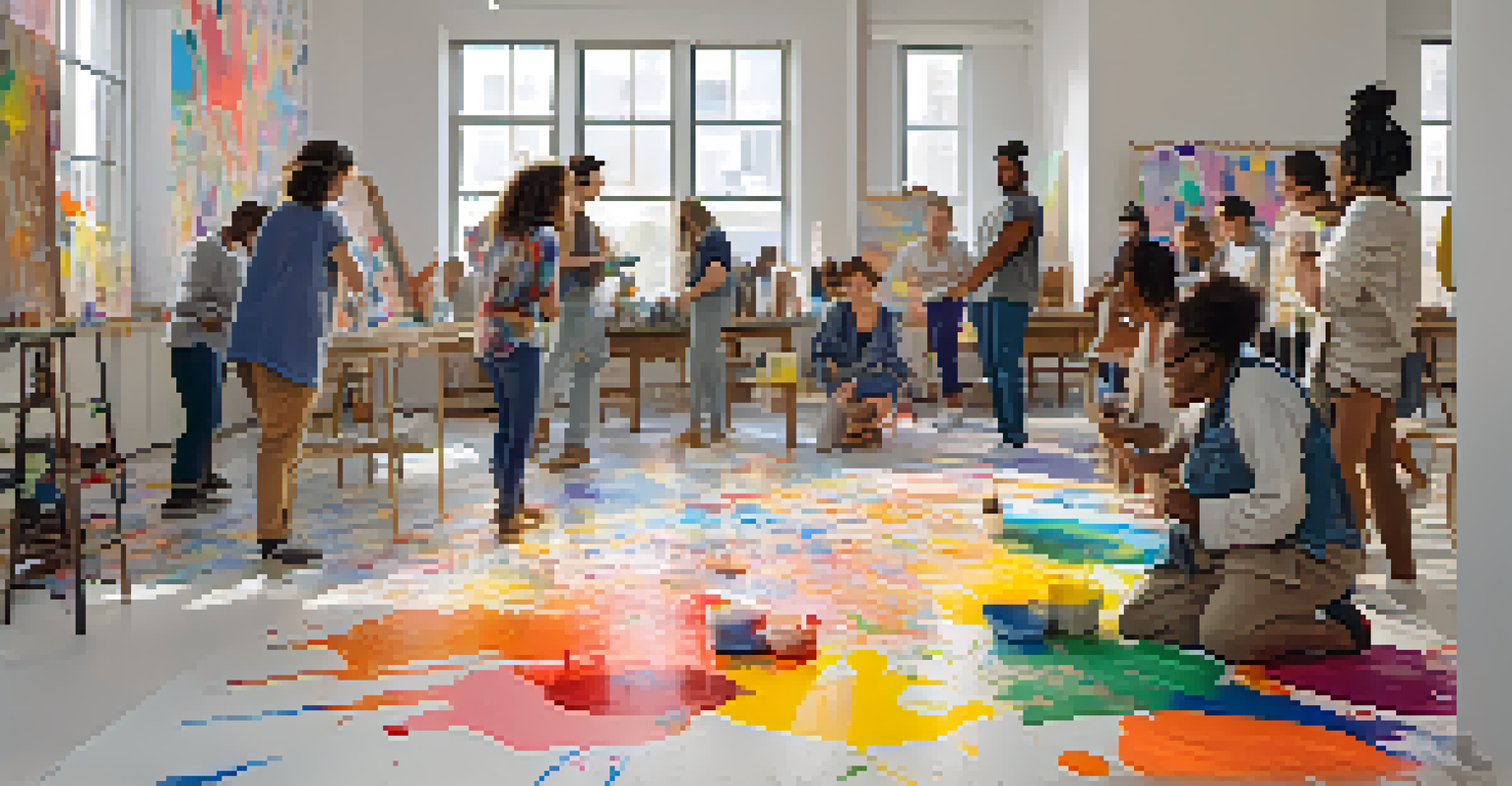The Role of Public Art in Shaping Civic Identity and Belonging

Understanding Public Art and Its Importance
Public art encompasses a wide range of artistic expressions, from murals to sculptures, displayed in communal spaces. It serves not only as decoration but as a reflection of the community’s values, history, and aspirations. By making art accessible to all, public installations create a shared cultural experience that connects individuals.
Public art is a bridge to connect people, a platform for voices that need to be heard.
Consider a vibrant mural in a city neighborhood depicting its diverse history. This piece doesn’t merely beautify the area; it tells stories of the people who live there, inviting passersby to engage with their surroundings. Such art can spark conversations among residents and visitors alike, reinforcing a sense of belonging.
In essence, public art acts as a visual dialogue between the community and its environment, shaping how residents perceive their identity within that space. This dialogue can inspire pride and ownership, ultimately contributing to a cohesive civic identity.
Public Art as a Tool for Community Engagement
One of the most powerful aspects of public art is its ability to engage community members in the creative process. Projects often involve local artists and residents, fostering collaboration that strengthens community ties. This participatory approach not only makes the art more meaningful but also helps individuals feel invested in their environment.

For example, a neighborhood may hold workshops where locals can contribute ideas or even physically participate in creating a mural. This inclusion transforms residents from passive observers to active participants, deepening their connection to the artwork and to each other. It empowers individuals, giving them a voice in how their community is represented.
Public Art Engages Communities
Public art fosters community engagement by involving local residents in the creative process, transforming them from passive observers to active participants.
When people feel a sense of ownership over their public spaces, they are more likely to take pride in them. This heightened engagement can lead to a stronger community identity, as shared experiences around public art foster bonds among residents, ultimately creating a more vibrant and connected society.
Public Art and Cultural Representation
Public art serves as a canvas for cultural representation, showcasing the diversity of a community. It provides a platform for various voices, particularly underrepresented groups, to share their stories and perspectives. This inclusivity not only enriches the artistic landscape but also fosters understanding and empathy among different cultural groups.
Art is not a thing; it is a way.
Take, for instance, a series of sculptures that celebrate the heritage of immigrant communities in a city. Such installations not only honor their contributions but also educate the wider public about their histories and cultures. This celebration of diversity through art can help break down barriers and promote unity.
When communities see their histories reflected in public spaces, it affirms their place within the civic identity. This representation encourages dialogue about shared experiences, creating a sense of belonging for all residents, regardless of their background.
The Role of Public Art in Urban Revitalization
Public art can play a pivotal role in urban revitalization efforts, transforming neglected areas into vibrant destinations. By strategically placing art in these spaces, cities can attract visitors and spark economic development. This revitalization not only enhances the aesthetic appeal but can also foster new business opportunities and community initiatives.
Imagine a once-derelict warehouse district that becomes a thriving arts hub. With murals, installations, and performance spaces, the area draws foot traffic, inspiring local businesses to open up shop. This transformation not only beautifies the environment but also instills a renewed sense of pride among residents.
Cultural Representation Through Art
Public art serves as a platform for diverse voices, showcasing the richness of a community's cultural heritage and promoting understanding among different groups.
As public art breathes new life into urban spaces, it creates a dynamic atmosphere that encourages social interaction. This sense of place can strengthen community bonds and contribute to a shared civic identity, reinforcing the idea that art and culture are integral to the fabric of everyday life.
Fostering Dialogue and Social Change Through Art
Public art often addresses pressing social issues, serving as a catalyst for dialogue and change. Artists can use their work to comment on topics like inequality, climate change, or social justice, inviting viewers to reflect on these critical matters. This engagement can inspire action and promote community involvement in addressing societal challenges.
For instance, a powerful installation addressing homelessness might provoke thought and discussion about local policies and support systems. Such art not only raises awareness but also encourages empathy, urging community members to consider solutions rather than merely accept the status quo.
By bridging the gap between art and activism, public art fosters an environment of open conversation. This dialogue can unite individuals across various backgrounds, helping to build a stronger, more inclusive community committed to positive change.
Public Art’s Influence on Civic Pride and Identity
The presence of public art significantly contributes to civic pride, as residents take ownership of their local culture and heritage. When people see art that resonates with their experiences, it cultivates a sense of belonging and attachment to their community. This pride can extend beyond the immediate area, shaping how outsiders perceive the city or neighborhood.
Consider a city renowned for its public art, drawing tourists and art enthusiasts from afar. The distinctive murals or sculptures not only showcase the local talent but also create a narrative that residents can proudly share. This shared identity fosters a collective pride that can enhance social cohesion.
Art Drives Urban Revitalization
Strategically placed public art can rejuvenate neglected areas, attracting visitors and stimulating economic development while enhancing community pride.
Ultimately, public art becomes a symbol of community values and aspirations, reinforcing a unique civic identity. As residents unite in appreciation of their surroundings, this pride can inspire collaborative efforts to further enrich the community, solidifying the bonds that tie individuals together.
Challenges and Considerations in Public Art Projects
While public art holds immense potential, it also faces challenges that must be navigated thoughtfully. Issues such as funding, maintenance, and community buy-in can complicate the realization of public art projects. Addressing these challenges requires collaboration among artists, city officials, and community members to ensure that the art truly reflects the needs and desires of the residents.
For example, a proposed mural may face opposition due to differing opinions on its theme or execution. Engaging the community in discussions before the project begins can help to alleviate concerns and foster a sense of shared ownership. This inclusive approach ensures that the art resonates with the community and contributes positively to its identity.

Additionally, ongoing maintenance and preservation are crucial to sustain the impact of public art over time. By establishing a plan for care and upkeep, communities can ensure that these artistic expressions continue to inspire and engage future generations, further solidifying their role in shaping civic identity.